

 |
The Art of Natural Forest Practice |
 |
CROESO>>> |
|
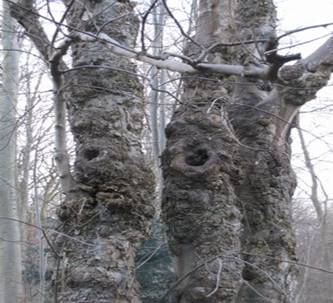 Cavities formed in sycamore by incorrect cutting of collar |
Cavity Trees in Healthy Woodland Cavity trees are very scarce in British woodland, the consequence of centuries of removing older trees. Their loss is very much to the detriment of the forest. The nest boxes we provide compensate for a while, but not adequately, for inevitably our interest flags and the boxes become neglected. What is really required is a long term strategy that contributes to the self-sufficiency of the woodland ecosystem. How do we Define a Cavity Tree? Associated with older trees; having one or more cavities, of various sizes, crevices, loose bark, decay from broken limbs, lightning strike, etc. Hollow trees are especially valuable. This is quite distinct from wildlife hotels well endowed with creepers (ivy and honeysuckle, etc), forked branches, etc of any age. Cavities have a microclimate which add to biodiversity and provide a niche for specialised forms of life such as fungi, ferns and plants that require dark and humid conditions to flourish. A Vital Source of Food, Shelter, Refuse, and Nesting In Britain cavity trees are used by owls and small birds; starlings, various tits, nuthatches, flycatchers, tree creeper, redstarts, jackdaws, etc, as well as dormice, bats, diverse insects and others. For nesting each species has its own specific requirements, evolved hand in hand with nature. In addition, refuge sites provide protection from the weather and predators. Bugs, larvae of wood-boring beetles, tree sap, etc, provide a source of food. How do Cavities Form? The following has been stimulated by Alex Shigo’s book Modern Arboriculture. Natural Cavities usually form where the branch joins the tree trunk. You’ll see rounded bulges where the loss of a branch has successfully healed, over, known as callusing. The branch is supported by a collar (Shigo: Section 64) and typically, as the branch slowly decays it prevents the collar from callusing over and thus a cavity begins to form. Experimental Cavity Trees In my woodland we are identifying trees with suitable branches on which we can experiment. We will modify the branch and collar and observe how the tree responds over some decades. Some cavities will be formed by nature, others by our cutting a branch short and also by making a ‘wildlife cut’ across the collar (Shigo: Section 73). Others will be clean cut to callus over as a control. We’ll choose a variety of branch sizes and observe how they progress and report back on this page. Actions * There must be a greatly increased AWARENESS OF the importance of cavity trees; * Cavity trees are important for Healthy Woodland Communities; * Tree Surgeons must be trained to make both types of cut - clean cuts and wildlife cuts and use them as appropriate; * Techniques for making cavities using a chainsaw should be developed; * Man-made nest boxes provide a short term solution to the absence of cavity trees. A long term strategy is required to provide food, shelter, and refuge * Tree surgeons must be trained in making and fixing large nest boxes, the design of which must accommodate * Aim for at least six Cavity Trees per hectare. Have you observed good cavity trees? Please send a photo. Your experience and comment will be greatly appreciated. |
|
|
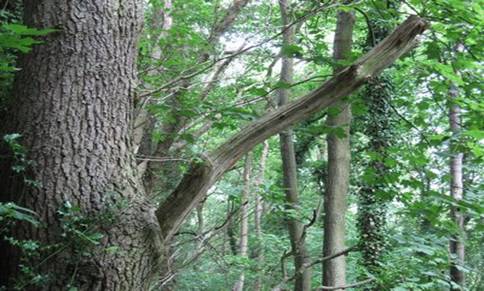 Decaying branch of oak tree with collar clearly visible that one day may become a valuable nest cavity. |
|
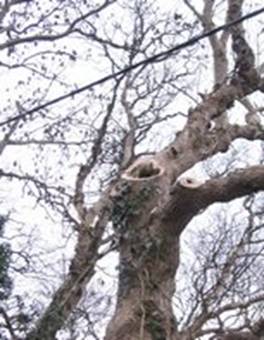 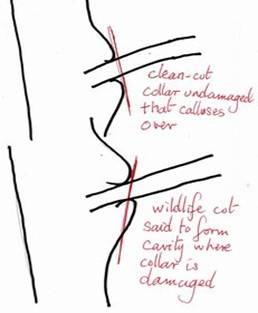 Incorrect cutting of ash tree to clear overhead power line, large cavity forming that could make it a very valuable tree. |
|
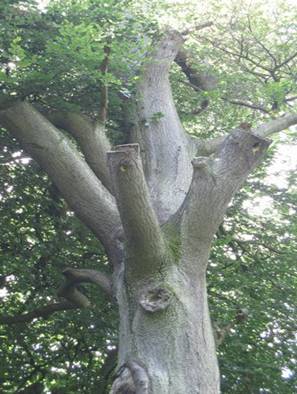 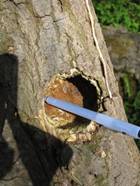 Woodpecker nests in beech and willow, the only species of fauna in Britain to excavate its own cavity. |
|
|
|
APPENDIX 1 - Benefiting from our Experience of Creating Cavities Using a Chainsaw DISCLAIMER:- These materials have been prepared for information purposes only. They are not intended to be nor do they constitute safety advice. The author accepts no responsibilty for their implementation.
|
|
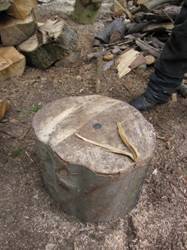 shows angle of cut made from narrow entrance. |
Best viewed in Firefox